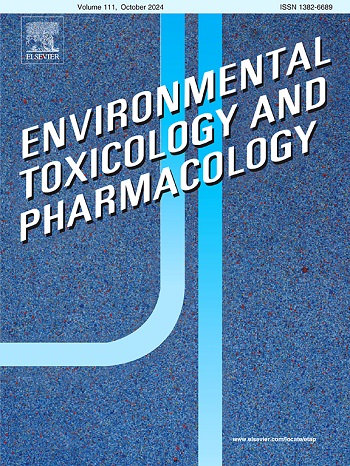Metabolism and genotoxicity of 4,4’-oxydianiline is dependent on N-acetyltransferase 2 genetic polymorphism
IF 4.2
3区 环境科学与生态学
Q2 ENVIRONMENTAL SCIENCES
引用次数: 0
Abstract
4,4’-oxydianiline (ODA) is an environmental aromatic amine reasonably anticipated to be a human carcinogen. We investigated ODA genotoxicity and oxidative stress modified by N-acetyltransferase 2 (NAT2) genetic polymorphism in yeast and DNA repair deficient (UV5) Chinese hamster ovary cells (CHO) expressing human NAT2*4 (rapid acetylator allele) or human NAT2*5B (slow acetylator allele) and in cryopreserved human hepatocytes from rapid, intermediate, or slow NAT2 acetylator genotypes. N-acetylation of ODA was both concentration- and time-dependent and significantly higher in yeast and CHO cells expressing NAT2*4 versus NAT2*5B. ODA-induced DNA damage response and reactive oxygen species (ROS/RNS) were significantly higher, while intracellular reduced glutathione (GSH) and oxidized glutathione (GSSG) ratio or mitochondrial integrity were significantly lower in CHO cells expressing NAT2*4 than NAT2*5B. Dose- and NAT2 phenotype-dependent responses also were observed in human cryopreserved human hepatocytes. Our findings have important implications for precise risk assessments following exposures to ODA and azo dye precursors.
4,4 ' -氧二苯胺的代谢和遗传毒性依赖于n -乙酰转移酶2的遗传多态性
4,4 ' -氧二胺(ODA)是一种环境芳香胺,被认为是一种人类致癌物。在表达人NAT2*4(快速乙酰化等位基因)或人NAT2*5B(慢乙酰化等位基因)的酵母和DNA修复缺陷(UV5)中国仓鼠卵巢细胞(CHO)以及快速、中、慢乙酰化基因型的人肝细胞中,研究了n -乙酰转移酶2 (NAT2)基因多态性修饰的ODA遗传毒性和氧化应激。ODA的n-乙酰化具有浓度和时间依赖性,在表达NAT2*4和NAT2*5B的酵母和CHO细胞中显著高于表达NAT2*4的细胞。在表达NAT2*4的CHO细胞中,oda诱导的DNA损伤反应和活性氧(ROS/RNS)显著升高,细胞内还原性谷胱甘肽(GSH)和氧化性谷胱甘肽(GSSG)比例或线粒体完整性显著低于表达NAT2*5B的CHO细胞。在冷冻保存的人肝细胞中也观察到剂量和NAT2表型依赖性反应。我们的研究结果对暴露于ODA和偶氮染料前体后的精确风险评估具有重要意义。
本文章由计算机程序翻译,如有差异,请以英文原文为准。
求助全文
约1分钟内获得全文
求助全文
来源期刊
CiteScore
7.00
自引率
4.70%
发文量
185
审稿时长
34 days
期刊介绍:
Environmental Toxicology and Pharmacology publishes the results of studies concerning toxic and pharmacological effects of (human and veterinary) drugs and of environmental contaminants in animals and man.
Areas of special interest are: molecular mechanisms of toxicity, biotransformation and toxicokinetics (including toxicokinetic modelling), molecular, biochemical and physiological mechanisms explaining differences in sensitivity between species and individuals, the characterisation of pathophysiological models and mechanisms involved in the development of effects and the identification of biological markers that can be used to study exposure and effects in man and animals.
In addition to full length papers, short communications, full-length reviews and mini-reviews, Environmental Toxicology and Pharmacology will publish in depth assessments of special problem areas. The latter publications may exceed the length of a full length paper three to fourfold. A basic requirement is that the assessments are made under the auspices of international groups of leading experts in the fields concerned. The information examined may either consist of data that were already published, or of new data that were obtained within the framework of collaborative research programmes. Provision is also made for the acceptance of minireviews on (classes of) compounds, toxicities or mechanisms, debating recent advances in rapidly developing fields that fall within the scope of the journal.

 求助内容:
求助内容: 应助结果提醒方式:
应助结果提醒方式:


